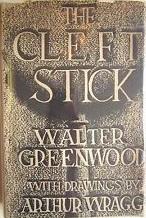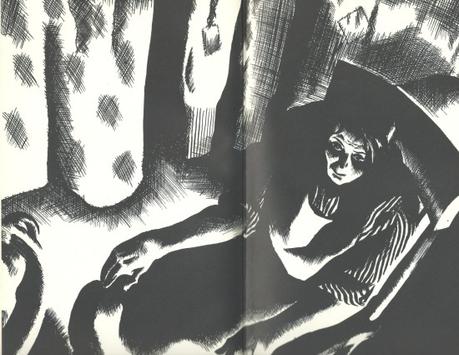
Review by Sylvia D: The Cleft Stick is a collection of 15 short stories. Although the book wasn’t published until 1937, all but two of the stories were written between 1928 and 1931. As Greenwood says in the Preface, they ‘were the products of the ‘prentice hand’ – (p9). They are all set in the part of Salford Greenwood dubbed Hanky Park and it seems that Ethel Mannin to whom he sent them for advice advised him to write a novel using some of the characters. Love on the Dole was the result.
The stories have no sense of chronology. The earliest in time is ‘Patriotism’, set in May 1915, when a local mob, incensed by the sinking of the Lusitania and hearing about thousands of people attacking Keppel’s butchers shop march on the emporium of Mr Schwartz and ransack it. This story features two themes which appear regularly in the collection. First, the resentment felt by the old, the unemployed and those struggling to survive against the few wealthy members of their community – the pawnbroker, the bookmaker Sam Grundy, the successful shopkeepers some of whom would give credit or sell on instalment, others who wouldn’t, and the local money lender, Alderman Ezekiel Grumpole. Mention of Grumpole points to the second recurring theme – the anti-semitism which we have come across so often in novels of the period. So of Swartz, ‘You wouldn’t mind if he was an Englishman, would you? But a blooming Jew’- (p 31).
The latest story in time is probably ‘A Son of Mars’ in which Ned Narkey, the drunken bully and ladies man in Love on the Dole, is now married, unemployed and the father of 10 children, seven of whom are surviving. The story opens with Ned Narkey and his wife waiting for the funeral of one of those who has died. Narkey himself refuses to go with the funeral carriage because he is waiting for the insurance man and he intends to spend some of the money on drink and philandering. Greenwood makes much of the way that insurance payments, the premiums collected on a weekly basis, became windfalls for hard pressed household, even to the extent of one woman in ‘The Practised Hand’ enlisting assistance in shockingly helping her dying lodger on his way. Greenwood was himself an insurance collector for a while and describes in ‘Patriotism’ the way ‘a swarm of men on bicycles with note-books and pens in their pockets’ would descend on a district onpay day. ‘these men were representatives of the burial clubs, insurance companies, landlords, weekly payment clothing clubs and all the other hirelings who were expect by their employers to cajole, bully and extract shillings and sixpences from the harassed women’ – (p 29).
A few of the stories are quite humorous. In ‘Mrs Scodger’s Husband’ we meet another character who appears in Love on the Dole. He was ‘A diminuitive person scarcely more than five feet’ and yet his trade was as a blacksmith. He is hen-pecked and never listened to by Mrs Scodger who on the other hand was a large woman. She had acquired a trombone which she played very badly and practised on two nights a week. Her decision to practice on a third night, a Friday, causes him to rebel and to her consternation takes himself off to the pub and then to the races where he wins a lot of money. Mrs Scodger is so amazed by the change in her husband that she abandons the trombone, only to use some of the money Alfred has won to replace it, to his horror, with a harmonium. At the very end of the story there is a little ironic twist which is a device Greenwood frequently uses.
In nearly all the stories Greenwood is dealing with the social problems of the time – the debilitating effects of having no money, single women who fall pregnant and the condemnatory attitude of their families and the community, even bigamy. There is also close observation of character and personal relationships.
The stories are imbued with the grinding poverty that haunted northern industrial towns during the Great Depression. Whilst the men can escape by taking themselves down to the pub, the married women suffer most – constant child-bearing, taking in washing and ironing or sewing for all hours to try to make ends meet, a poor diet that sapped their strength, old before their time. The story, ‘The Cleft Stick’, is probably the most poignant. ‘She [Mrs Cranford] dropped the basket of washing on the rug before the fire, flopped into the rocking-chair, sighed and closed her aching eyes. Her arms, wet to the elbows where there were splashes of lather, hung helplessly. Her mouth was open and her breathing laboured. A stupefied listlessness numbed her brain making everything as vague as a waking dream. She heard the kettle lid rattling, but she was too tired to take it off the fire’ – (p 59). The arrival of a letter from the landlord telling her she must clear her arrears of rent or quit the house is the final straw and she resolves to end it all. So she puts her head in the gas oven and turns on the gas only to remember resignedly that she hadn’t even a penny to feed the meter.
The other particularly poignant story is that of Stephen Wain, a dull man with no family, set in his ways, who spent most of his working life in a cheerless office in Manchester writing deeds in his perfect copperplate. He sees the work slowly drying up as typewriters take over. He is laid off and has to live on his savings and his old age pension. ‘It was bewildering, this break in one’s habits. He wakened of a morning and found that there wasn’t any place to go’ – (p 169). Then he caught pneumonia, was taken to the infirmary and two days later was dead. His landlady threw his beloved pens into the fire. The story is entitled ‘A Quiet Life’.
In his Preface Greenwood says, ‘Had it not been for a holiday in Cornwall last year when I spent a good deal of time in the company of my friend Arthur Wragg, the artist, I guess the short stories comprising most of this volume would still be in their shabby brown-paper parcel. For me, Wragg’s drawings really enhance the collection. Born in1898, he trained at the Sheffield School of Art before settling in London as a freelance commercial artist. He was a socialist and pacifist and as such chose to concentrate on illustration rather than fine art. He wanted to speak directly to common people rather than to art-lovers. In the 1920s his work was mainly covers for women’s magazines but then he branched out to do book-jackets and to work for left-wing newspapers such as Tribune and Peace News and to produce drawings for books and pamphlets about Christian socialism, pacifism and social justice. He illustrated several biblical texts in a politicised way as well as the novel, I was a Prisoner, the prison experiences of William Holt, a Todmorden man who was sentenced to nine months in Wakefield prison for protesting against the Means Test. The drawings of this period are done in a very dramatic black and white style leading some to say they resemble woodcuts rather than pen and ink drawings. He was a sponsor of the Peace Pledge Union and a conscientious objector during the Second War. His experience of imprisonment resulted in him publishing an illustrated edition of Wilde’s The Ballad of Reading Goal in 1948. Later he designed record covers for the Argo record company.
Arthur Wragg’s Illustration for the story, ‘The Cleft Stick’:


